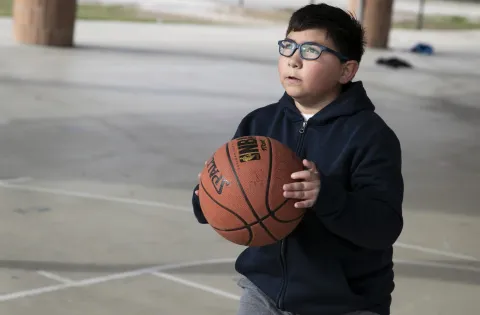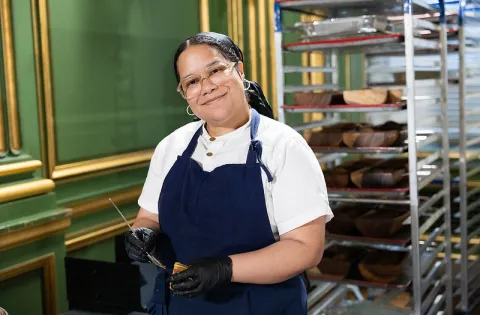This week, the Biden administration signed an executive order that immediately puts into place measures to help states and local governments partner with restaurants to feed more children in need during the COVID-19 pandemic.
No Kid Hungry convened a panel of experts to explore this concept, which was formally introduced in bipartisan legislation called the FEED Act, and its impact on the 1 in 4 kids that could face hunger today as well as the hard-hit restaurant industry.
This order increases the federal cost share of FEMA assistance, including emergency food deliveries, making them 100% reimbursable. This offers a dual win for our nation. Not only will it help more vulnerable communities get the food they need, but it achieves this by employing our nation’s restaurant industry, helping to keep their doors open and workers employed.
“The executive order means we won’t have to worry about whether or not the bill is going to languish in legislative limbo,” said Monica Gonzales, director of federal advocacy at Share Our Strength’s No Kid Hungry campaign. “This measure brings forward every resource the government has to address this national hunger crisis and opens the door to innovative ways in which we can feed children.”
Tackling the record-high level of food insecurity is critical. While federal nutrition programs like SNAP, Pandemic EBT and school meals are important tools, this executive order offers an immediate way for other emergency meal programs to tap into existing federal resources so they can scale up operations.
“This [executive order] is to compliment all of the feeding that is going on at this time,” said Gonzales. “This is building on innovative partnerships. We know how to feed people during a natural disaster, but this is not a natural disaster. Everybody is in this crisis.”
This week’s executive order is also good news for the restaurant industry, which has been economically devastated by the pandemic.
“The food and beverage industry was the hardest hit of all industries when it comes to this pandemic, and it’s also seen the least amount of direct support,” said Nate Mook, CEO of World Central Kitchen. “Over 110,000 restaurants have been closed and more than half of those say they will never return. Over the course of the last 11 months, more than 8 million restaurant employees were laid off or furloughed.”
The types of partnerships this executive order support can already be found across the country.

For decades, chefs and restaurants have been partners in the fight against hunger.
World Central Kitchen has been deploying restaurants to help feed communities nationwide during the pandemic through its program Restaurants for the People. The program pays restaurants to produce meals that then get distributed to members of the local community.
“The real key here is that every dollar that goes back into these restaurants ends up paying for staff, paying for the food coming from suppliers,” said Mook. “It keeps that economic engine going so that the business can keep running and [restaurant workers] can keep buying food so they don’t become food insecure themselves.”
This partnership has helped thousands of restaurants in the U.S, like Boston’s MIDA Restaurant, which worked with World Central Kitchen to feed the city’s frontline healthcare workers.
“We had to close down for about a month and a half, then this opportunity [from World Central Kitchen] came along,” said Douglass Williams, chef and owner of MIDA Restaurant. “It was a scary time and everyone was just spinning. We said we have to align our compass and let’s get this going.”
The program got everyone at the restaurant involved.
“Front of the house people were cooking in the back and chopping vegetables and grabbing knives. It was a lovely, crazy and exciting time because everybody just wants to work and we were also helping our own community,” Williams said. “We were able to bring not just people back to work, but also bring the mojo and the enthusiasm, which is what food does.”
The bonus? “It’s rejuvenating to the economy,” said Williams.

Making meal services like these 100% reimbursable is a game-changer, especially for nonprofits supporting these partnerships.
“We’re limited by how much people are willing to give,” said Mook. “This is where the FEED Act really comes into play because it will enable programs to be able to tap into existing federal dollars that are already allocated for this disaster. This is existing money that’s sitting there for this pandemic, but it puts it to work in a much smarter capacity.”
With the FEED Act set in motion through this executive order, states and local governments can immediately take advantage of these FEMA dollars.
“It will be incumbent upon local agencies, cities, counties, governors, state agencies to work together with nonprofits and others to get those plans in front of FEMA and get them approved immediately,” said Gonzales.
“Moving it to 100% reimbursement opens the doors for those [local] governments to step forward and to begin implementing these programs knowing that it’s not going to bring them a bigger budget deficit than they’re already facing,” added Mook. “They know that there is a lot of food insecurity in their communities. And it’s not that they don’t want to address it or that they didn’t want to put local restaurants to work. It became a budgetary issue that left a huge cost burden on governments that were already way overstretched because of the impact the pandemic was having.”
It’s this type of teamwork that leads to the kinds of public-private partnerships between states, nonprofits and restaurants that are serving the greater good and solving childhood hunger.
“No one was not affected by this [crisis],” added Williams. “I think that solidarity is imperative and important and applicable to what is actually happening.”


